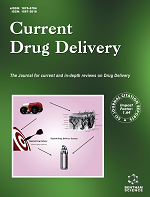- Home
- A-Z Publications
- Current Drug Delivery
- Previous Issues
- Volume 16, Issue 10, 2019
Current Drug Delivery - Volume 16, Issue 10, 2019
Volume 16, Issue 10, 2019
-
-
Floating Drug Delivery Systems: An Emerging Trend for the Treatment of Peptic Ulcer
More LessAuthors: Ankit Namdev and Dharmendra JainFloating drug delivery system (FDDS) is the main approach to prolonging the gastric residence time in the stomach in which the bilayer floating tablet has the main role. It is more suitable for the treatment of local infections such as peptic ulcer, gastritis, Zollinger-Ellision syndrome, indigestion, and other local infections related to the gastrointestinal tract and also used for systemic applications. FDDS provides protect Read More
-
-
-
Drug Delivery and Targeting to the Brain Through Nasal Route: Mechanisms, Applications and Challenges
More LessAuthors: Kanchan Kashyap and Rahul ShuklaBlood-brain barrier (BBB) provides restrictions for the transportation of various therapeutic agents to the brain. Efforts to directly target the brain by olfactory as well as trigeminal nerve pathway, bypassing BBB, have grown significantly in recent times. The intranasal route of transportation of the drug encompasses ability for the delivery of drug directly to the brain, improves site-specificity in the brain and avoids systemic side Read More
-
-
-
Design and Development of Novel Transdermal Nanoemulgel for Alzheimer’s Disease: Pharmacokinetic, Pharmacodynamic and Biochemical Investigations
More LessAuthors: Sonal Setya, Tushar Madaan, Bal K. Razdan, Mamta Farswan and Sushama TalegaonkarBackground: Alzheimer’s disease is a chronic progressive neurodegenerative disorder associated with depletion of acetylcholine. Oral treatment with tacrine hydrochloride; a reversible inhibitor of acetylcholinesterase, finds limited use in Alzheimer’s disease due to frequent dosing, hepatotoxicity and extensive pre-systemic metabolism. Objectives: The objective of the study was to evaluate pharmacokinetic, pharma Read More
-
-
-
Effect of Solution Properties and Operating Parameters on Needleless Electrospinning of Poly(Ethylene Oxide) Nanofibers Loaded with Bovine Serum Albumin
More LessBackground: This paper presents the effect of solution properties and operating parameters of polyethylene oxide (PEO) based nanofiber using a wire electrode-based needleless electrospinning. Methods: The feed solution was prepared using a PEO dissolved in water or a water-ethanol mixture. The PEO solution is blended with Bovine Serum Albumin protein (BSA) as a model drug to study the effect of the electrospinnin Read More
-
-
-
In vivo Antiplasmodial Activity of Curcumin-Loaded Nanostructured Lipid Carriers
More LessAuthors: Hamid Rashidzadeh, Mahsa Salimi, Somayeh Sadighian, Kobra Rostamizadeh and Ali RamazaniBackground: It has been shown that curcumin (Cur) has anti-plasmodial activity; however, its weak bioavailability, rapid metabolism, and limited chemical stability have restricted its application in clinical usages. Nanostructured lipid carriers (NLCs) are a type of Drug-Delivery Systems (DDSs) whose core matrix is composed of both solid and liquid lipids. Objective: The aim of the current study was to prepare and characterize c Read More
-
-
-
Utilization of a Single Experimental Design for the Optimization of Furosemide Modified-Release Tablet Formulations
More LessAuthors: Marilena Vlachou, Angeliki Siamidi and Yannis DotsikasBackground: The loop diuretic drug furosemide is widely used for the treatment of edema in various conditions, such as pulmonary, cardiac and hepatic edema, as well as cardiac infarction. Furosemide, due to its poor water solubility and low bioavailability after oral administration of conventional dosage form, is categorized as class IV in the biopharmaceutical classification system. Objective: In the case of furosemide Read More
-
-
-
Improving Topical Skin Delivery of Monocrotaline Via Liposome Gel-based Nanosystems
More LessAuthors: Jiandong Yu, Zhi Chen, Yan-zhi Yin, Chaoyuan Tang, Enying Hu, Shuang Zheng, Qi Liu and Yang XiongBackground: In this study, a liposomal gel based on a pH-gradient method was used to increase the skin-layer retention of monocrotaline (MCT) for topical administration. Methods: Using the Box-Behnken design, different formulations were designed to form liposome suspensions with optimal encapsulation efficiency (EE%) and stability factor (KE). In order to keep MCT in liposomes and accumulate in skin slowly and selectively, Read More
-
-
-
Release Kinetics of Nicotine Loaded onto Mesoporous Silicate Materials for Use in Nicotine Replacement Therapy
More LessAuthors: Fadia Ijbara, Dua'a M. Marzouqa, Murad A. Al Damin and Hamdallah A. HodaliObjective: In this work, the loading of nicotine onto mesoporous silicate materials and its release into a phosphate buffer solution at 37°C were investigated. Methods: The mesoporous silicate materials designated as MCM-41 were prepared with different pore sizes via using alkyltrimethylammonium bromide surfactants with different alkyl chain lengths of carbon atoms 12, 14, and 16. The mesoporous silicate Read More
-
Volumes & issues
-
Volume 22 (2025)
-
Volume 21 (2024)
-
Volume 20 (2023)
-
Volume 19 (2022)
-
Volume 18 (2021)
-
Volume 17 (2020)
-
Volume 16 (2019)
-
Volume 15 (2018)
-
Volume 14 (2017)
-
Volume 13 (2016)
-
Volume 12 (2015)
-
Volume 11 (2014)
-
Volume 10 (2013)
-
Volume 9 (2012)
-
Volume 8 (2011)
-
Volume 7 (2010)
-
Volume 6 (2009)
-
Volume 5 (2008)
-
Volume 4 (2007)
-
Volume 3 (2006)
-
Volume 2 (2005)
-
Volume 1 (2004)
Most Read This Month
Article
content/journals/cdd
Journal
10
5
false
en

Most Cited Most Cited RSS feed
-
-
Preface
Authors: Deng-Guang Yu and He Lv
-
- More Less

